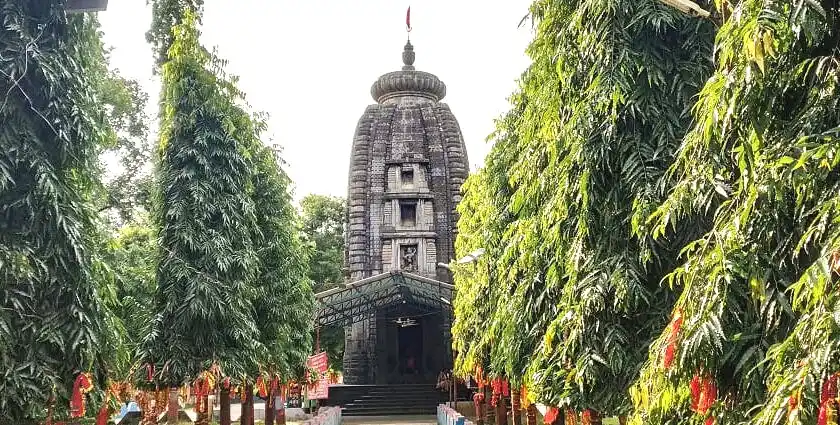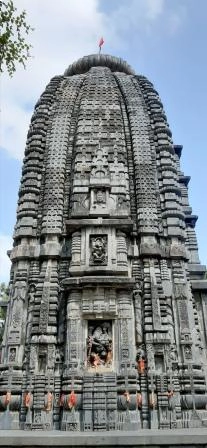
Table of Contents
Nestled in the serene land of Mayurbhanj, Odisha, the Kichakeswari Temple in Khiching is not just a place of worship—it is a treasure of history, heritage, and devotion. Far from the rush of modern cities, this ancient sanctuary whispers tales of royal patronage, architectural brilliance, and spiritual power. If you’re someone who loves exploring temples of Mayurbhanj, especially the ones less commercialized yet deeply impactful, then this blog is for you.
Where is Kichakeswari Temple Located?
Khiching (historically known as Khijinga Kotta) is located about 150 km from Baripada and 25 km from Karanjia, in the district of Mayurbhanj, Odisha. The temple stands near the confluence of the rivers Khairibhandana and Kantakhairi, making the setting naturally tranquil and spiritually uplifting.
The Bhanja Kings made this region their capital and ruled it from the 9th to the 12th century AD, demonstrating deep-rooted faith and patronizing temple art and architecture.
Who is Worshipped in the Kichakeswari Temple?
The presiding deity of the temple is Maa Kichakeswari, a fierce form of Goddess Chamunda, also known as Khijingeswari. She was the tutelary deity of the Bhanja dynasty. The image of the Goddess is awe-inspiring—seated on a lotus, with eight arms, and a skeletal figure that radiates divine power and fearlessness.
This unique portrayal symbolizes the raw power of Shakti and holds deep spiritual significance for devotees and historians alike.
The Architectural Marvel of the Temple

The present-day Kichakeswari Temple underwent reconstruction between 1934 and 1941, after the original 10th-century temple collapsed due to weak foundations. Notably, architects designed it in a unique Khiching style of Indo-Aryan architecture. As a result, the structure stands as a Pancharatha Rekha Deula—a temple with five vertical segments on its surface and a curvilinear spire.
In contrast to temples in Bhubaneswar, this one lacks a porch. However, it compensates with its elegant verticality, intricate carvings, and artistic richness.
Did You Know? The temple rises to 68 feet and cost ₹80,000 in 1942—a monumental sum at the time!
History of the Temple: A Royal Devotion
During excavations in 1922–24, archaeologists discovered the original temple’s foundation. Subsequently, recognizing its religious importance, Maharaja Purna Chandra Bhanja Deo initiated the reconstruction of the shrine with proper planning and conservation, even before heritage conservation became mainstream.
However, although his sudden death interrupted the project, the Archaeological Department eventually resumed and completed it by 1941. Finally, they reinstalled the deity in March 1942 amidst great fanfare.
Khiching Museum: Preserving the Past
Adjacent to the temple lies a site museum built by the Maharaja, which houses a range of ancient sculptures discovered during excavation. Furthermore, images of Durga, Mahishasuramardini, Saptamatrika and numerous Parivaradevatas (companion deities) reflect the prominence of Shaktism in the region and the artistic richness of that era.
Why Visit Kichakeswari Temple Today?
- Firstly, experience a less-commercialized pilgrimage site.
- Secondly, witness a rare form of Goddess Chamunda.
- Additionally, admire Khiching’s distinct temple architecture.
- Moreover, explore an ancient royal capital with deep cultural roots.
- Finally, immerse yourself in the serene and spiritual landscape of rural Odisha.
People Also Ask: FAQs
1. Who built the Kichakeswari Temple in Khiching?
The original temple was likely built in the 10th century by the Bhanja Kings, while the modern temple was reconstructed by Maharaja Purna Chandra Bhanja Deo and completed in 1941.
2. Which goddess is worshipped in Khiching?
Devotees worship Maa Kichakeswari, a fierce form of Goddess Chamunda, at this temple.
3. What is the architectural style of the Kichakeswari Temple?
It follows the Indo-Aryan Rekha Deula style, uniquely adapted in the Khiching region with no porch.
4. Is there a museum near the Kichakeswari Temple?
Indeed, there’s a site museum that houses ancient sculptures and temple relics excavated from the site.
5. Why is Kiching historically significant?
Kiching was the ancient capital of the Bhanja dynasty, reflecting rich religious and cultural traditions from the 9th–12th century.
Plan Your Visit to Khiching Today!
Kichakeswari Temple isn’t just a religious destination—it’s a walk through Odisha’s lesser-known yet glorious cultural chapters. If you’re planning a spiritual trip or a cultural tour across Eastern India, this spot deserves a place on your itinerary.
Pro Tip: Visit during local festivals or heritage walks in Mayurbhanj to experience the cultural richness in full bloom.
If you love exploring Odisha’s hidden spiritual gems, heritage sites, and unexplored temples, then go ahead and follow our blog. Furthermore, feel free to share your visit experiences or ask questions in the comments below!

Pingback: Pipili Chandua – The Colourful Soul of Odishan Handicraft